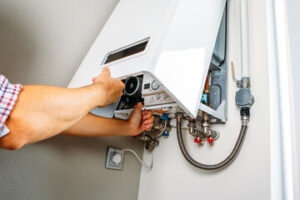The Woodlands Plumber install and maintain pipe systems that deliver water, waste, and gases. They also repair faulty pipes and fixtures. They often work in cramped and awkward spaces.
Plumbers usually start their career as an apprentice, working under the supervision of a journey plumber. They can complete a vocational school program or take an apprenticeship training program.

Plumbers are tradespeople who install, repair, and maintain pipes that transport water, gas, and waste in homes or businesses. Their duties include unclogging drains and fixing leaks, installing kitchen and bathroom fixtures like bathtubs, sinks, toilets, and appliances with water line connections such as washing machines and refrigerators, and diagnosing plumbing problems. Plumbers also remodel and renovate existing piping systems.
Plumber job responsibilities vary depending on the type of project or client. They may be required to perform routine maintenance, diagnose issues, and provide solutions or install complete piping systems and other plumbing components such as fire sprinklers, water filters, water heaters, and drainage systems. Plumbers are also on call for emergencies and may work weekends and evenings to respond to customer calls.
Generally speaking, a plumber’s duties require strong written and verbal communication skills and an understanding of complex ideas and processes. They must communicate clearly with assistants, managers, business owners, and homeowners to discuss project requirements, answer questions, and address concerns. Plumbers must also be able to read blueprints, drawings, and schematics.
Because they work with raw sewage and other potentially harmful substances, plumbers are at risk for exposure to infectious diseases. They are at particular risk for infection from hepatitis, cholera, and typhoid. They are also at risk for injury due to falling or working off ladders, scaffolding, or airlifts.
Qualifications that make a person a good plumber include problem-solving, analytical thinking, and interpersonal skills. They must be able to weigh various options and solutions before choosing the best one for each situation. Additionally, they should be able to climb and work off ladders or other elevated equipment and be physically capable of performing their duties, such as lifting heavy pipes.
The best way to find qualified applicants for a plumber job is by posting a clear, concise job description. This should include the required hours, full-time or part-time, and the salary range. Including this information in the job description can save time interviewing candidates not interested in or qualified for the position.
Those who wish to pursue a career as a plumber must first earn a high school diploma or equivalent. They should then enroll in technical courses related to plumbing and other skilled trades. Some of these courses can be completed online. Others can be found at local community colleges, vocational schools, and unions.
The next step for aspiring plumbers is to complete an apprenticeship program. This type of training combines classroom study with paid on-the-job experience. Generally, the length of an apprenticeship lasts between four and five years. During this time, apprentices are born at about 50 percent of the journeyperson’s hourly rate. Those who want to shorten the length of their apprenticeship should take college classes related to their field of work.
In addition to completing a technical program and gaining experience as an apprentice, aspiring plumbers must also obtain a license to work independently. This involves passing a test and submitting proof of experience in most states. Many states also require aspiring plumbers to complete a continuing education program to keep their licenses current.
Other important skills that a plumber should possess include excellent communication skills. They must be able to listen to customers’ complaints and determine the cause of problems. They must also be able to make repairs quickly and efficiently. Plumbers often need to travel to homes and businesses to perform their duties, so they must be able to drive and be comfortable working outdoors in all weather conditions.
Plumbers must also be aware of the health hazards associated with their profession. For example, they may be exposed to harmful microorganisms when repairing sewage systems. These germs can be excreted in fecal matter or vomit and could potentially lead to infections like cholera, typhoid, and hepatitis. Because of this, plumbers must wear protective clothing and take all necessary precautions to prevent illness or injury. In addition, a plumber must maintain a clean driving record and stay drug-free. Please do so to avoid the loss of a job. Some states also have specific regulations about the length of time a plumber must be licensed.
Plumbers work in various environments, including homes, commercial buildings, and construction sites. They often work in tight spaces and can be exposed to dust, dirt, and other hazards. They may also risk exposure to toxic substances and hazardous waste. For this reason, plumbers must always follow safe work practices and wear appropriate personal protective equipment (PPE).
Plumbers are also required to keep up with industry standards and regulations. As such, they need to participate in ongoing training and professional development. This is especially true if they want to advance in the profession. Plumbers can also join professional organizations that offer networking opportunities, educational resources, and other benefits.
Many states require plumbers to complete an apprenticeship training program before becoming licensed. This can last up to four years and involves a combination of classroom instruction and on-the-job learning. While apprenticeship programs vary by state, most require aspiring plumbers to log a certain number of hours working on industrial and commercial plumbing projects under the supervision of a licensed supervisor.
Once plumbers have completed their apprenticeship, they can seek employment at various locations. They may choose to work for a large plumbing company or may prefer to freelance. Regardless of the environment they choose, plumbers must be prepared to travel between jobs and be on call for plumbing emergencies at any time.
The demand for plumbers is steady, and job stability is relatively high. In addition, skilled plumbers can establish their businesses and command higher hourly rates than those with less experience. This makes the field an excellent choice for those looking for a career with growth potential.
A plumber’s salary can vary based on many factors, including location, experience, education level, and certifications. Plumbers can choose to work for a construction company, plumbing contractor, or maintenance department and may also be self-employed. Some plumbers also specialize in certain areas of plumbing, such as sewer and drain systems or commercial or residential heating and cooling.
Plumbers who have extensive skills and experience in a particular area of plumbing often earn higher salaries than those with basic training and skills. Plumbers with advanced certifications can also command higher pay since they demonstrate a commitment to their craft and a desire to continue their professional development.
The economy and climate of a region can also influence salaries. For example, plumbing services are more in demand during colder seasons when pipes are more likely to freeze and break. Plumbers may also be able to charge higher rates for emergency services, as clients are willing to pay a premium for immediate help during plumbing emergencies.
In addition to a base salary, plumbers can also receive performance-based bonuses. These bonuses are usually based on various factors, such as customer service scores or the ability to complete projects within budget and on time. Some companies also give out goal-based bonuses based on specific targets a plumber must meet to receive the reward.
Another way that plumbers can increase their earning potential is to invest in tools and equipment that can improve their efficiency and productivity. This can help them take on more jobs, which means they’ll be able to earn more money per hour. Furthermore, some plumbing professionals can boost their earnings by offering various services. For instance, a plumber with welding and HVAC (heating, ventilation, and air conditioning) expertise can provide these services to more customers and earn higher pay. Similarly, a plumber who offers green plumbing services can attract a more diverse clientele and achieve higher rates for their work.

